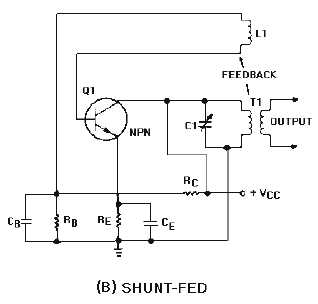2-12
By modifying the circuit slightly, it becomes a SHUNT-FED, TUNED-COLLECTOR
ARMSTRONG OSCILLATOR as shown in view (B). The dc component flows from ground through RE
to Q1 to positive VCC. The dc is blocked from the tank circuit by capacitor C2. Only the ac component
flows in the tank circuit.
Figure 2-9B.—Series- and shunt-fed, tuned-collector Armstrong oscillators. SHUNT-FED.
The function of an oscillator is to produce a sinusoidal waveshape of a specific frequency and
amplitude. In doing so, the stability of an oscillator is very important. Depending on its application, an
oscillator may be required to have either good frequency stability or amplitude stability; in many
circumstances, both are required. Of the two, good frequency stability is usually considered more
important.
FREQUENCY STABILITY
The FREQUENCY STABILITY of an oscillator is a measure of the degree to which a constant
frequency output is approached. The better the frequency stability, the closer the output will be to a
constant frequency.
Frequency INSTABILITY (variations above and below the desired output frequency) may be caused
by transistor characteristics or by variations in the external circuit elements.
As stated before, when output power is not of prime importance, transistor oscillators may be biased
class A to ensure stability and minimize distortion. When this is done, the dc operating point established
by the power supply is chosen so that the operation of the transistor oscillator occurs over the most linear
portion of the transistor's characteristic curve. When the operation of the circuit falls into the nonlinear
portion of the characteristic curve, the transistor's parameters (voltages and currents) vary. These
parameters are basic to the stable frequency of the transistor oscillator. Operating frequency variations
may occur with changes in these bias voltages. Thus, a constant supply voltage is a prime requirement for
good frequency stability.
The use of a common bias source for both collector and emitter electrodes results in a relatively
constant ratio of the two voltages. In effect, a change in one voltage is somewhat counteracted by the
change in the other. This counteraction takes place because an increase in collector voltage causes an


